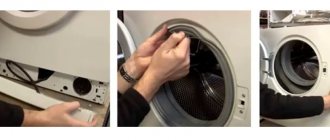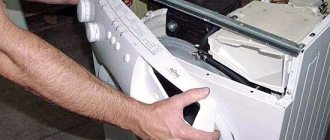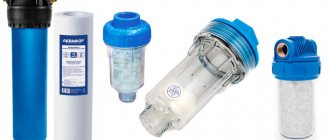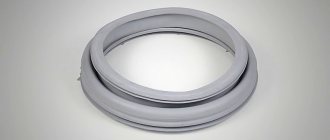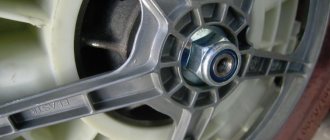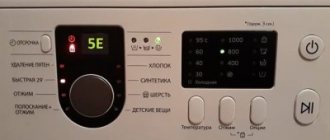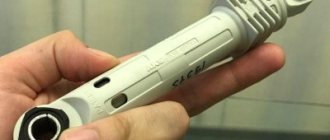Types and features of drain hoses
The product is a light-colored polypropylene hose with rubber fittings of various diameters (from 18 to 22 mm) at both ends. Its main function is to drain liquid into the sewer during operation. Depending on the length and function, there are 3 types of drain hoses. These include:
- Regular drain hose. It has a fixed size (from 1 to 5 meters). If it is necessary to increase the length, connect the two products using two clamps and an extension.
- Telescopic universal hose. Initially, the compressed size of the device is about 60 cm. In working condition, the device stretches up to two meters. The main disadvantage of the product is its susceptibility to blockages and strong vibration due to the corrugation of the hose.
- Coil-shaped hose. It is a product on which notches are applied, allowing you to measure the required length and shorten the module (0.5 m). If you use a hose that is too long, this will lead to clogging, stagnation and, in the future, breakdown of the machine. Therefore, it is recommended to cut the module to the optimal size.
Different models of washing machines have different locations and fastenings of the drain hose. However, there are general troubleshooting steps that are recommended to be performed regardless of the brand.
To begin correcting a problem with the product, drain the liquid from the washing unit. To do this, you will need to remove the lid at the bottom, unscrew the drain filter and release the water.
The drain pump has failed
During operation of the unit, a situation may arise that the liquid does not drain from the tank. Then you will need to replace the drain pump.
To do this, you don’t even need to remove the plastic panel of the washing machine, since the pump is changed from the bottom (for brands such as Samsung, Indesit, LG washing machine and others). The operating algorithm is as follows:
- Turn off the power to the unit and close the water tap.
- Lay down the fabric and place the machine on it. In this case, there should be a drain pump on top.
- Using a screwdriver, unscrew the screws and remove the pump.
- We press on the drain pump and take it out.
- Disconnect the wires going to the pump. To do this, simply remove the spare part from the pump.
- We drain the remaining liquid into a container prepared in advance by loosening the clamps and disconnecting the drain hose with the pipe.
- We install the new pump in the washing machine, performing the steps in the reverse order, securing it with bolts or snapping it onto the fasteners (for example, in some Samsung models).
Important! Before screwing on the new part, clean the snail from blockages and dirt.
In German brands, to replace the drain pump, the front panel is removed, and in top-loading equipment (for example, Zanussi), the rear wall is removed. A detailed algorithm for replacing the pump with photographs is given here.
To ensure that your washing machine lasts a long time and performs its functions without failure, follow the recommendations for replacing major parts and monitor the operation of the equipment, as well as adhere to the recommended preventative care measures.
Location of the drain hose base at the rear
This option is used by the following home appliance manufacturers: Indesit, Lg, Samsung, Beko, Candy, Ardo, Whirpool, Ariston. Once the panel has been removed (as described above), follow these steps to install a new drain hose:
- Take a photo of the clamp attachment to ensure proper installation of the new product.
- Loosen the clamp and completely unfasten the part.
- Slowly remove the old hose and secure the new product using the photo.
- Reassemble the parts in reverse order.
- After connecting the free end to the drainage system, check the tightness of the connection.
Replacing the drain hose in automatic machines from AEZH, Bosch and Siemens
In such models of washing machines, it is very easy to get to the drain hose by opening the front wall. Initially, you need to loosen the clamp (the fastening collar that is tightened with a bolt). Then remove the hatch cover, which is located at the bottom of the front wall of the car. Remove the container for powders and other detergents and the decorative panel. Dispose of any remaining water from your washing machine.
Remove the mounting bolts and remove the panel. Turn off the power to the car and disconnect the wires designed to block the above-mentioned hatch. Loosen another clamp that secures the hose and disconnect it. Insert the new hose and install the fastening element (clamp). Attach the hose itself to the walls of the housing and lead it outside.
Location of the drain hose base on the front panel
This option is used by such manufacturers of home appliances as Bosch, Siemens. To replace the drain hose of the washing machine, remove the front plastic surface. To do this, move the bottom panel to a distance of about 5-6 cm and unfasten the connector with wires from the module locking device. Then we slide the panel towards us and set it aside.
When access to the drain hose is open, remove the part by loosening the clamp and removing the fixing elements with a screwdriver. We replace the part of the machine with a new one, performing the steps in the opposite order. At the end, do not forget to check the tightness of the connection of the parts to the pump, and whether there are any kinks in the hose.
We change the drain hose on Ariston, Ardo, Beko, Candy, Indesit, LG, Samsung and Whirpool machines
In machines of this group, access to the place of attachment of the failed hose is through the bottom.
- Unfasten the base wall covering the pump filter.
- Pour out the remaining water by carefully unscrewing the filter.
- Move the washing machine away from the wall and tilt it back so that it rests against the wall.
- Having gained access to the drain hose, disconnect it from the drain system and loosen the clamps with pliers.
- After marking the location of the factory drain part in the inside of the case, unfasten it and take it out. To ensure that nothing interferes with dismantling work, it is worth additionally removing the top wall of the washing machine.
- Install the replacement element and carry out assembly work in the opposite order.
- Connect the tube to the sewer lines and test both ends for leaks.
Location of the drain hose base on the side
For washing equipment with vertical loading, this part is located differently: on the side wall. Therefore, you need to do all the steps described above, but only by removing the side panel. To do this, you need to unscrew the bolts that are located on adjacent sides of the panel. Then move the side of the structure, lowering it down. After freeing access to the hose, you need to unfasten its internal part and replace it with a new product.
Preparatory process
To replace the hose, it is necessary to disassemble the equipment by disconnecting the part from the pump. It is more convenient to first remove the cover from the machine by performing the following sequence of actions:
- Unscrew the screws on the back wall of the device.
- Slide the cover back.
- When the panel comes out of the grooves, remove it and set it aside.
Depending on access to the drain hose for machines from different manufacturers, different options for further actions can be distinguished. Let's look at the main ones: the drain product is located in the front, side or rear of the structure.
How to remove the back panel of a washing machine
When does the drain hose need to be replaced?
The drain hose serves to drain waste water, so it is attached to the drain pump, next to the pipe. It is made of polypropylene, so it can withstand water of different temperatures and also remains resistant to chemicals.
For what reasons does he need a replacement?
- Inappropriate element. Often, when you purchase a washing machine, you receive a hose included. However, it may be short during installation. Of course, you can lengthen the element, but this increases the risk of water leakage.
- Mechanical damage. Replacing the washing machine drain hose may be necessary if there is a fracture or a leak. It is recommended to replace the part immediately.
- The hose is so clogged with debris and scale that it needs to be replaced.
Installation of drain hoses in various models of washing machines
Replacing the drain hose of different brands of washing machines will be similar, since it is attached to the body of the washer. To carry out banner work, access to the building must be opened. The main differences in different models can only be in the type of access due to the design of the machine.
Initially, you need to disconnect the hose from the pump, having first gotten rid of all fasteners. To make repair work more convenient, remove the top cover. If the washing machine drains water directly into the sewer and the pipe connection is treated with sealant, carefully remove it with a sharp object and disconnect the corrugation. After this, drain the remaining water from the pipe after washing the machine.
disconnecting the drain hose from the pump
Do not overuse the tilting of the washing machine in different directions.
For more details, watch the video:
Why change it?
The drain hose in the washing machine is necessary to drain the used water. It is located next to the pipe and extends from the drain pump, which in turn ensures the flow of liquid into the hose. As a rule, it is made from polypropylene. This material allows it to remain resistant to high water temperatures and aggressive detergents. But, despite its high strength, replacing the hose on a Samsung machine becomes necessary over time. Let's look at the main reasons that require installing a new pipe.
- Lost connection. The washing machine comes with a standard length hose. Often, to lengthen it, the owner builds it up. Most often, a break occurs at the junction.
- Damage. Possible mechanical impact on the part leads to rupture of the material. Water is leaking. Replacement is urgently needed.
- Congestion. Over time, scale accumulates on the inner walls of the hose, residues of washing powder stick, and water can no longer pass through the pipe.
If the drain pump is broken
When operating a Samsung washing machine, you may encounter a problem when waste water is not drained from the unit. First of all, they begin to look for the problem in the hose itself, but it is likely that in addition to it, the pump will have to be replaced.
To do this kind of work, you don’t even have to dismantle the machine panel, because the pump in the Samsung model is changed from the bottom. The sequence of actions is as follows:
- the machine is disconnected from the electrical network, the water supply tap is turned off;
- a cloth is spread on the floor on which the washing machine is placed. It should be positioned so that the drain pump is on top;
- use a screwdriver to unscrew the screws and remove the pump;
- by pressing on the drain pump, we take it out;
- disconnect the wiring connected to the pump;
- pour the remaining liquid into a container prepared in advance, loosen the clamps, disconnect the drain part along with the pipe;
- We mount the pump, proceeding in the reverse order, screw in the bolts. By the way, before installing a working pump, do not forget to clean the snail from the dirt accumulated inside it.
In principle, when replacing the pump, a new drainage part can be installed.
Replacing the washing machine drain hose yourself
Household appliance manufacturers produce many different models of washing machines.
They differ in technical characteristics, capabilities, the presence of additional functions, and appearance. Despite these differences, their main task is washing clothes, which requires adding and draining water. Water enters and leaves the machine using hoses. During operation, the drain hose of the washing machine may become damaged and will need to be replaced. This operation is not particularly difficult to perform, so you can do it yourself, taking a little time. Depending on the model of the washing machine, the location and fastening of the drain hose differs. But there are a number of general actions that need to be done regardless of the model.
Before proceeding with the replacement, you need to disconnect the machine from communications - electricity and water supply.
How to seal a hole in a hose reliably?
There are several methods floating around on the Internet for fixing the drain hose of a washing machine, but not all of them are reliable in reality. So, amateur craftsmen often recommend a simple option - sealing the crack with electrical tape. It is necessary to wrap not only the hole itself, but also 10 cm on both sides of it, in several layers, sparing no adhesive tape.
If you wrap the torn area on the hose only with electrical tape, then after a while the water will break through the “patch” and a leak will occur.
It is difficult to judge whether the method with electrical tape is reliable: it all depends on the size of the crack, the quality of the tape and the effort applied. In any case, professional craftsmen offer a more durable option - fixing a plastic tube in a torn hose with your own hands. The instructions are as follows:
- prepare two steel clamps and a tube (the latter should have a length of 8 cm and a diameter commensurate with the existing drain hose);
- find a crack in the corrugation;
- cut the sleeve in the damaged area, opening access to the “insides”, but without cutting completely;
- generously lubricate the prepared tube with sealant;
- insert the tube first into one half of the corrugation, then into the other (it is desirable that the cut runs in the middle);
- feel the hose and find both ends of the inserted tube;
- fix the clamps on both ends of the tube over the hose.
If you repair a corrugated hose in this way, the “patch” will last for several years. The water drained from the machine will pass through the tube, bypassing the torn area. This will prevent leakage. There is only one “minus” - the area between the clamps will not bend.
Preparing for replacement
Replacing a drain hose is a slightly more labor-intensive process compared to replacing a fill hose. To replace the drain, you need to disassemble the washing machine and disconnect it from the pump. Depending on the manufacturer of the machine, the hose inside can be routed and secured in different ways. To make it more convenient to work, you can first dismantle the top cover of the machine. This is done as follows:
- unscrew the screws holding the lid - they are located on the back wall of the machine;
- Having unscrewed the screws, the cover must be moved back so that it comes out of the grooves;
- remove and set the cover aside.
Further actions depend on the specific brand of equipment. There are several common options for accessing the drain hose, which are similar for certain manufacturers due to the design features of the machine models.
General principles when replacing a hose
All washing machines require an individual approach to replacing the drain hose. However, the initial steps to solving the problem are general.
The first thing to do is disconnect the equipment from the power supply. If the device is working, you need to wait until the laundry is washed and then turn it off. It is recommended to secure the power cord to the back wall so that it does not interfere during operation.
The next step requires disconnecting from the central water supply and draining the water from the device. To do this, you need to remove the large lid at the bottom of the machine and unscrew the drain filter; water will flow from it. Preliminary work on replacing the hose has been completed. To continue working, you need access to the inside of the washing machine. All machines have a different internal structure and location of the drain hose.
Replacing the hose for models Ardo, Whirpool, Samsunq, Ariston, Candi, LG, Indesit, Beko
For models Ardo, Whirpool, Samsunq, Ariston, Candi, LG, Indesit, Beko, it is easier to replace the hose than for others. The part can be accessed from the bottom of the device. To get started, you need to take the following steps:
- remove the outer panel, drain the water and unscrew the filter;
- the bolts that hold the “snail” need to be unscrewed and disconnected from the machine body;
- loosen the clamps securing the hose to the pump and remove it;
- disconnect the hose from the drainage system and only then from the body (it is important to remember how it was attached and located inside the equipment);
- a new corrugation is installed, and repeating the previous steps, all parts are installed in their places;
- It is important to check the joints for reliability and tightness.
Installing a hose on Zanussi and Elektrolux washing machines
For Zanussi and Elektrolux brand models, the drain hose is replaced through the back wall of the device. To get to the breakdown you need:
- Unscrew the screws and remove the top cover from the machine;
- Unscrew the bolts that hold the back panel and remove it;
- disconnect the intake valve retainer and open the rear cover;
- straighten the hose and wait until the water flows out of it;
- loosen the clamps from the drain system and the housing;
- remove the hose;
- install a new corrugation;
- installation of all spare parts in their original place;
- perform a test wash.
Replacing the drain hose for Bosh, AEG and Siemens washing machines
Installation of a broken drain corrugation in such models is the most difficult, as it is carried out through the front panel of the case. In order to make a replacement you need:
- remove the detergent container;
- detach the base panel;
- you need to loosen and remove the clamp that holds the rubber seal;
- remove the filter from the drain pump and drain the water;
- unscrew the screws holding the front panel;
- on the inside you need to find the hatch locking device (it is located near the hole into which the hook goes when the door is closed) and disconnect the wires;
- remove all fixing elements from the hose and disconnect it from the pump, wait until the water runs out;
- Disconnect the hose from the housing and drainage system;
- install a new corrugation;
- carefully check the connections for leaks;
- return all parts to their places;
- carry out a test wash.
How to get to the drain hose
That is why, to replace the machine hose, you need to disconnect the hose from the drain pump, and only then from the body of your washing unit itself.
To make it more convenient for you, you can disconnect the top hatch of the machine.
Let's look at several options for gaining access to the drain hose connection, based on the individual characteristics of each design from various groups and subgroups.
Replacing the drain hose of Electrolux and Zanussi washing machines
In washing designs from Electrolux and Zanussi, access to the elements inside is achieved by opening the back wall of the panel, since the bottom is almost impossible to open, and the front panel does not open at all.
How to remove the back cover
- Remove the outer cover of the washing device. To do this, unscrew the 2 fastening screws from the rear panel, move the cover back and disconnect it.
- Next, you should start unscrewing the screws on top and a couple on the sides (they can be found under the plugs), and two or three on the bottom.
- Separate the plastic fastenings of the intake valve from the rear panel and carefully disconnect the rear wall.
How to remove and install a drain hose
- After dismantling the back panel, we gained access to all elements. Now you need to drain the remaining water through the drain hose. To do this, lower it as low as possible and place some kind of cup and rag in advance for backup.
- Next, we look for the fastening of our hose and disconnect it by loosening the clamp.
- We disconnect the hose from the body, first remembering the location.
- We attach the new part in place of the old one and secure it with a clamp.
- We connect the free end to the sewer and check the level of tightness.
- We assemble the back panel in descending order of all the steps described above.
Changing the drain hose in an AEG, Bosch and Siemens washing machine
In these cases, you can get an inlet to the drain hose fastener for washing units of this group through the front panel.
How to remove the front panel
- Release the clamp and carefully disconnect the hatch cuff from the front panel of the washing machine body.
- Remove the dispenser.
- Detach the decorative panel at the very bottom.
- Pour the remaining water through the pump filter element, after placing a rag under it.
- Unscrew the screws securing the front panel to the device body. One bolt will be at the top and 2 at the bottom.
- Move the lower part of the socket slightly towards you, then move it down and disconnect the entire socket by about 5-8 cm.
- Disconnect the cords from the blocking holes that are located on the wall.
How to remove and install a drain hose
- When you finally have access to the interior of your washing machine, remove the drain hose clamp and disconnect the hose from the drain structure.
- Insert the new hose tightly in place of the old part, and clamp it all with a clamp.
- Next, we run the hose along the walls, attach it to the shell of the device and bring it outside.
- Connect the end of the hose (outlet) to the sewer and check your installed part for tight connections.
Changing the drain hose in washing machines Ariston, Indesit, Samsung, Ardo, VEKO, LG, Sandy and Whirpool
In washing units of this group, access to the hose, or rather its fastening, can be found through the bottom of the structure.
- Disconnect the lowest socket that secures the pump filter.
- Pour out the remaining water, taking great care to unscrew the filter.
- Pull the washing machine forward, and when you tilt it back, place it against the wall.
- Starting work at the bottom of the device, unscrew all the screws securing the snail, remove it from the body and lower it.
- Once you have access to the drain hose, disconnect it from the drain system, first loosening the clamp using pliers.
- Try to remember the location of your old drain hose in the middle of the body, and then disconnect it and remove it. For convenience in this type of dismantling, we recommend removing the outer cover of the structure.
- Connect the newly purchased hose and reassemble the machine in reverse order.
- Connect the hose to the sewer and check the tightness of the drain hose connections on both sides.
Replacing the drain hose on AEG, Bosch and Siemens washing machines
To get closer to the place where the drain element is secured in machines of this category, you should resort to dismantling the front panel.
- Remove the clamp and remove the hatch cuff from the front wall of the washing machine.
- Remove the dispenser.
- Unfasten the decorative panel next to the plinth.
- Pour the remaining water through the pump filter, placing a cloth underneath to absorb it.
- Unscrew the bolts securing the front panel to the body of the washing machine (1 at the top and 2 at the bottom).
- Bend the bottom of the panel towards you, pull it down and unfasten the entire panel.
- Remove the wiring from the hatch lock located on the panel.
Removing the old and installing a new hose
- After gaining access to the inside of the machine, unfasten the clamp from the tube and remove the hose from the drainage system.
- We mark the attachment points of the factory element, detach it from the walls of the case and move it outside.
- We insert the new tube tightly into place of the old one and press it with clamps.
- We run the drain hose along the walls of the machine, attach it to the body and lead it outside.
- It is necessary to correctly connect the outlet end of the tube to the sewer lines and test both ends for leaks.
See also -
What to do if your washing machine is leaking - an overview of possible causes
replacement option for top-loading machines
Changing the drain hose in this type of washing machine is much easier. In most cases, you can get to the inner end by unfastening the side wall. To do this you need to do a number of actions.
- Unscrew the screws located at the end of the rear wall and one at the end of the lower part on the front side of the machine.
- Slide the side panel towards the back, then lower it down and remove it.
- Having provided access to the hose and unscrewing the holding clamp, it can be disconnected.
- Now you need to detach the inner part of the hose from the machine body.
- Taking it out of the washing machine, put it on and attach the new one.
Now everything is ready, you can assemble the machine in reverse order. When it is assembled, you need to connect the outer end of the hose to the sewer and check the tightness of the connection.
Replacing the drain hose in washing units such as Electrolux and Zanussi
It is possible to replace the drain hose of an Electrolux or Zanussi washing machine only through the back wall. First you need to remove the top cover of the washing unit, that is, unscrew the fastening bolts on the rear panel. You also need to unscrew the same bolts at the rear wall and remove it. Next, you should disconnect the intake valve fasteners by first removing the rear panel. Do not forget to drain the remaining water and slightly loosen the clamps from the body and from the drainage system, and remove the corrugated drain hose. Install the new hose and put all the parts back together. Check the operation of the washing machine.
Types and reasons for replacing the drain hose
The automatic washing machine (CMA) drains the water from the tub after each wash and rinse cycle. The liquid immediately passes through the pipe, is drawn in by the pump, and then discharged through the hose into the sewer. When the drain tube needs replacement:
- The new washing machine contains all the elements for connection. Often, it is the drain hoses that are short and do not reach the drainage system. Therefore, you have to buy a suitable part.
The tube can always be extended, but the more joints there are when connecting, the higher the risk of leakage.
- The element was damaged and bent. It is not recommended to practice insulation; it will not last long. It's better to find a replacement right away.
- The device is very clogged and leaky. Even special products do not help eliminate the unpleasant odor.
When purchasing, make sure that the hose matches the length and diameter of the seat. If you are choosing an element for a new SM, then its varieties are presented below.
Types of drain hose:
- Bulk. The device is assembled from several modules 50–55 cm long.
The standard length of the drainage tube is from 1 to 5 meters.
- Telescopic. The corrugated element can stretch from 0.5 to 1.5 meters. When installing, you need to stretch it carefully so as not to damage the corrugation. The disadvantage of this design is strong vibration when draining.
Most often, hoses are made of polypropylene with rubber fittings.
How to replace the drain hose in a washing machine?
The outer part of the sleeve is attached with clamps to the rear wall of the machine. The rest of the part goes deep into the housing and is connected to the pump. But each model has different design features. Let's look at how to remove and change the hose using the example of different models.
Before starting any work with equipment, follow safety rules and unplug the machine. Also close the inlet valve.
If the machine has already been used, start by removing any remaining water.
- Open the small hatch at the bottom of the front wall.
- Place the container.
- Unscrew the filter plug counterclockwise.
- Wait for the drain.
For further work, also prepare rags and towels, because water may flow during dismantling.
AEG, Bosch, Siemens. To gain access to the product, you will have to remove the front panel.
- Remove the top cover by unscrewing the mounting screws from the back.
- Open the door, bend the cuff and remove the clamp using a slotted screwdriver.
- Unscrew the two door lock bolts (UBL).
- Place your hand behind the body and pull it out. Disable contacts.
- Pull out the dispenser, press the latch in the center and remove it from the housing.
- Remove the screws around the perimeter of the control panel. It can be removed or placed on top of the case.
- Unscrew the front panel mounting bolts. Remove from place.
Below the tank you will see fastenings for the drainage elements. How to remove the hose is shown below.
Ariston, Indesit, Ardo, Samsung, Beko, LG, Candy, Whirpool. The manufacturers of these machines have provided the easiest access to components - through the bottom.
- Tilt the SMA body back so that it is convenient for you to carry out repairs.
- Place a rag under the bottom.
- If the interior is covered by a panel, remove the screws and remove the panel. Sometimes a leakage sensor is attached to the bottom of the lid. Unfasten its contacts and unscrew the mounting bolt.
- Proceed with replacement.
You can take pictures of the disassembly stages in advance so that you can easily install the parts in place.
Electrolux, Zanussi. In these models, the front panel does not separate, so you can access the sleeve through the back wall.
- Remove the top cover.
- To dismantle the back wall, unscrew the screws along the side seams. The fasteners can be hidden by plugs, just pry them off with a screwdriver.
- Now you need to disconnect the inlet valve, which is attached to the rear wall.
- Disconnect its wiring and tighten the screw.
- Slide the panel back and detach.
How to replace
In all washing machines, the outer part of the hose is attached to the rear wall using clamps, and the rest is attached to the drain pump. You need to disconnect it. In the most common brands (Ardo, Ariston, LG, Beko, Samsung, Indesit, Whirpool), access to the pump is through the bottom. The machine should be placed at an angle and the bottom panel should be removed. Next, you need to loosen the metal clamp used to secure the connection between the hose and the pump and disconnect the old hose, and install a new one in place of the old one. Reassemble in reverse order.
To prevent water leakage, make sure the clamp is tight enough. Otherwise, you will have to repeat the disassembly again to eliminate the leak. In Zanussi and Electrolux washing machines, you need to remove the back wall to remove the drainage hose. To access it, you must first remove the top cover, which is secured using bolts located on the back side, unscrew the bolts holding the back cover and unscrew the screws securing the filler valve. Disconnect the old hose.
In Siemens and Bosch washing machines, you will have to do more labor-intensive work, since access to the drain hose is through the front panel. These machines require the powder receptacle and bottom panel to be removed first. Then the clamp and cuff are removed, the bolts holding the front cover are unscrewed and the door lock latches are removed. After removing the cover, access to the drain hose is free. You can make a replacement. After replacing the drain hose, check to see if there is any water leakage. Connect the machine and set the rinse mode.
When is it necessary to replace?
It may be necessary to replace the hose with a new one in several cases:
- insufficient length of the existing one;
- material wear.
If the integrity of the hose is damaged, it is recommended to replace it completely. Repair with clamps is not advisable due to poor reliability and short service life. For the same reason, it is not recommended to extend the missing length.
A clogged hose is not a serious reason to replace the part. If it is not worn, it should be cleaned and returned to its place. But in cases where, in addition to the blockage, there are cracks and general wear and tear, it is better to replace it in order to prevent a serious leak from occurring.
Prevention measures
Usually, a clogged washing machine hose occurs on its own. Small objects cannot get into it, as they will get stuck in the pump or drain filter.
This can be avoided by following these rules:
- Wash items using a special bag;
- Use water softeners;
- Regularly descale the machine;
- Wash only using powder - automatic;
- Before washing, turn clothing pockets inside out and remove all foreign objects from them.
How to buy a new hose
As you can see, the replacement can be done quite easily. But sometimes the problem arises because the wrong hose was purchased. Of course, you can resort to simple tricks to avoid mistakes. For example, take an old one with you to the store. Or write down the model and provide information to the sales consultant. We propose to understand what types of drain hoses exist. And then you can choose what you need yourself, without relying on the competence of the store employees.
- Standard or classic hose. It fits almost any model. The length varies from 1 to 5 meters, this is quite enough to install a washing machine in any room.
- Telescopic. The hose can stretch up to one and a half meters. On the one hand, this advantage is very convenient. On the other hand, when stretched, the material between the folds vibrates strongly.
- Bulk. This hose consists of modules approximately half a meter in size. It is convenient because, due to its design, it allows you to adjust the length.
After making sure that you have chosen the correct new part and following the instructions described above, you can easily replace the damaged hose with your own hands.
Replacing the drain hose for Electrolux and Zanussi machines
To change the drain of these washing machines, we will need a little more effort, because we will no longer have access to the hose through the bottom, and therefore we will have to remove the back wall.
First, let's remove the top cover, to do this, unscrew the two screws that are located on the back and push the cover back, after which it can be easily removed. Now unscrew the bolts holding the back cover. But we won’t be able to remove it right away, because it’s held in place by the filler valve. In order for us to remove the cover to the side, we need to unscrew the bolts securing this valve. For convenience, it is best to remove the inlet hose.
After this, the back wall of the machine can be safely removed. Now disconnect the drain hose from the pump by loosening the clamp (similar to the above washing machine models). Next, we remember how the drain is attached to the walls of the washing machine, or better yet, take photographs. Now we detach it from the walls and put it aside.
Now is the time to get a new drain hose. First of all, we throw it through, as we did earlier, lay the old hose (we do not fasten it) and attach its end to the pump and fix it with a clamp. Next, attach the hose to the body of the washing machine. We install the back cover, the fill valve on it and the top cover in place. We connect the machine to the water supply and sewerage and carry out a test wash. There should be no leaks at the connection points.

